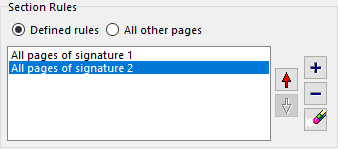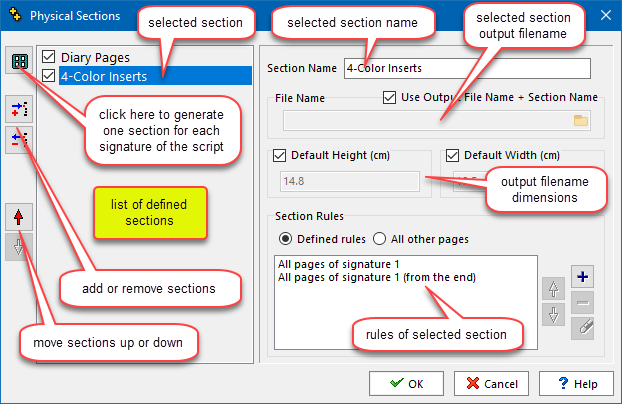Property of the script line: Book Format.

To split the output of a script into many different files, set the Output Type property is set to sections. This can be needed if some pages of a diary are to be printed on a slightly larger sheet size, or different paper stock.
To the right are details of the currently selected physical section.
Section Name
This is a name which you can select as you wish to identify each section. Examples are "front and back liners", "8 page customer artwork" and "diary body". The only restriction is that, within a given script, the section names must be unique.
File Name
You can set a filename to hold the output of the corresponding section, but it is usually best to keep the default option use output filename + section name checked. This will generate output filenames for each section made up of the script's output filename, to which the name of the section is appended.
Note that Q++Studio removes spaces and other potentially problematic characters from the section names before appending them.
By default the height and width of each section is set to be the same as that of the Size property of the script. In the rare case when it is necessary (different size paper, or bleed for a given section), you can override those.
Section Rules

Rules can be added, deleted or modified using the buttons at the bottom right of the rules editor.
In each script, one Physical Section can be set to all other pages, the other sections must have rules attached to them. It is usually a good idea to have one section defined as all other pages, to ensure that all pages of the script are part of the output.
Each page of a script may belong to only one rule of one section.
If the rules of the various sections use the same page more than once, an error will be displayed in the Messages Window. On the other hand, if some pages are not used by any of the rules of any of the sections, then a warning will be issued. Finally, the order in which the rules are displayed is there solely for your viewing convenience. The pages concerned by each rule are unambiguously defined, without regards to the order in which these rules are enunciated.
Even though there are many rules governing the above settings, you do not need to remember them all, since Q++Studio will generate a design-time message if either of them is violated.
See also: Physical Sections Rules, Output Type.
Topic 114000, last updated on 21-Oct-2021
